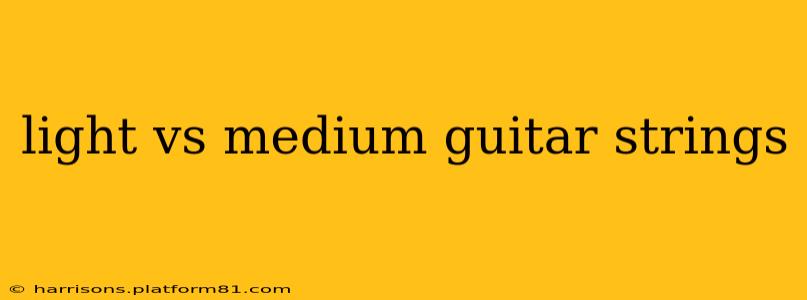Choosing the right guitar strings can significantly impact your playing experience. The tension, feel, and tone all depend heavily on the gauge (thickness) of the strings. A common point of confusion for many guitarists, especially beginners, is the difference between light and medium gauge strings. This comprehensive guide will delve into the nuances of light vs. medium guitar strings, helping you determine which is best suited for your needs and playing style.
What's the Difference Between Light and Medium Guitar Strings?
The primary difference between light and medium guitar strings lies in their gauge, which refers to the diameter of each string. Medium gauge strings are thicker than light gauge strings, resulting in a higher tension when tuned to pitch. This difference in tension affects several key aspects of playing:
- Tension: Medium gauge strings have significantly more tension than light gauge strings. This leads to a firmer feel under the fingers.
- Tone: Medium gauge strings generally produce a fuller, richer, and potentially brighter tone, with enhanced sustain and projection. Light gauge strings often sound warmer and mellower.
- Playability: Light gauge strings are easier to bend and play for extended periods, making them popular among beginners and players with smaller hands or those prone to hand fatigue. Medium gauge strings require more finger strength and can be more challenging initially.
- Tuning Stability: Medium gauge strings tend to stay in tune better than light gauge strings, particularly in humid or fluctuating temperature conditions. However, this stability comes at the cost of increased string tension.
What Gauge Are Light and Medium Guitar Strings?
While specific gauges vary between manufacturers, a general guideline is as follows:
Light Gauge (typically .009 - .042): These are the thinnest commonly available strings and are ideal for beginners or players who prefer easier bending and less hand fatigue.
Medium Gauge (typically .010 - .047): These strings offer a balance between playability and tone, providing a fuller sound and improved tuning stability.
It's crucial to always check the specific gauge numbers on the string packaging, as variations exist between brands.
Which Gauge is Right for Me? Light or Medium?
The best gauge for you depends entirely on your individual preferences and playing style. Here's a breakdown to help you decide:
Choose Light Gauge Strings if:
- You're a beginner: Lighter strings are easier to press down and will make learning chords and scales more comfortable.
- You have smaller hands: The reduced tension will alleviate strain on your fingers.
- You play primarily fingerstyle: Light gauge strings allow for more nuanced fingerpicking and faster transitions.
- You play styles that require frequent bending: Bending strings is easier with lighter gauge.
- You prefer a warmer, mellower tone: Lighter gauge strings produce this characteristic tone.
Choose Medium Gauge Strings if:
- You want a brighter, fuller tone: Medium gauge strings offer increased projection and sustain.
- You play styles that benefit from a strong, resonant tone: Genres like rock, blues, and some country styles may benefit from medium gauge strings.
- You need improved tuning stability: Medium gauge strings hold their tuning better over time and changing environmental conditions.
- You have stronger fingers and are comfortable with increased tension: This is a crucial factor for choosing medium gauge strings.
What about other string gauges?
Beyond light and medium, you'll also find heavy gauge strings (.011-.050 or higher) offering even greater tension, richer tone, and excellent tuning stability but significant challenges for those without considerable finger strength. Extra light (.008-.038) are even lighter than light gauge for the ultimate ease of playing, at the cost of tuning stability and tone fullness.
How do string gauges affect my guitar?
The tension from different gauges can impact your guitar's neck. Heavier strings can potentially cause neck relief issues, while lighter strings can cause the neck to bow slightly. Regular setup by a qualified guitar technician is essential to maintain optimal playability regardless of the string gauge used.
Ultimately, experimenting with different gauges is the best way to discover what feels and sounds best for you. Don't hesitate to try both light and medium gauges to find your perfect match!
